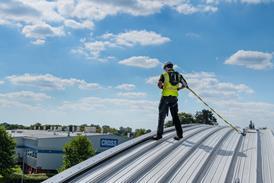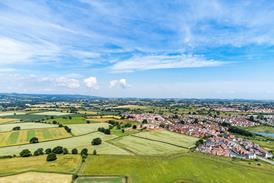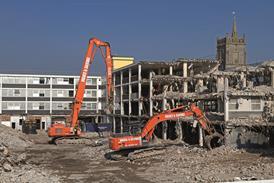Nonetheless, blown fibre has a unique ability to deliver cost-effective solutions in the backbone and campus. It even enables fibre to the desk (fttd) at an affordable price. For a growing number of users with dispersed bandwidth-hungry applications it's the only way to go; examples include aerospace contractors, cad offices and companies engaged in stock dealing and currency trading. The high bandwidth capabilities of blown fibre also make it an ideal backbone channel for videoconferencing and security cctv applications.
With costs falling at the same time as user bandwidth requirements are rising, it's clear that many more organisations will shortly opt for blown fibre.
There are only a few UK suppliers of this innovative technology, one of which is Krone. Recognising the growing advantages, the firm has embraced the solution into its PremisNET cabling portfolio.
Fibre in motion
Even 'seen everything' techies find it hard to suppress a feeling of amazement as they watch fibres snaking their way along the duct pipes in which they are blown.
The key difference of blown to conventional fibre cabling is that you lay low-friction, plastics tubing instead of fibre cable in buildings and across campuses. For example, you might be putting in an entirely new fibre network and using blown fibre throughout or installing it alongside conventional fibre cable as an inexpensive option to provide future extra bandwidth and capacity. You may even be installing the duct tubing alongside Category 5e or 6 copper to allow for possible future fibre-to-the-user needs.
The relatively inexpensive duct tubing can be laid everywhere liberally, with optical fibre (single or multi mode) blown into place when required using compressed air. Economy is the key word here: fibres are installed in bundles of 2-12, meaning there is no need to provide more cable than necessary. Network expansion and upgrades are simple and cost-effective, with new fibre bundles simply being blown into spare tubes.
Even better, fibre bundles can be removed if and when they are no longer required, freeing up ducts for further future expansion. The fibre has no stress placed on it so suffers no damage in the process. Installation is remarkably rapid too, up to 35 metre per minute, depending on the route.
Varied fibre diet
Variety is the spice of life and the ways and means of blown fibre are by no means rigid. It can be used purely for campus and backbone systems, but a further area of flexibility is realised when the technique is used to deliver connectivity all the way to users, either as far as the comms closet on each floor (converting there to copper), to a node near a particular user-group (again converting to copper) or all the way to the user.
Users have a choice as regards the topology (routing) of the system. This can be as per copper (backbone, actives, horizontal) in what is termed a distributed FTTD network. Alternatively, you can opt for a Home-Run fttd network, in which fibre runs directly from all points in star formation back to the comms room. This latter option, using long-reach fibre is generally cheaper on account of the fewer actives and comms closets needed.
Cost considerations
Because the fibre is laid only as required, blown fibre reduces initial capital outlay. When additional capacity is needed or a technology change dictates upgrading to a newer or higher bandwidth fibre type, blown fibre enables that new outlay to be committed only when the need arises, not years in advance as with most contingency solutions. Plus, the disruption of the conventional solution to expansion and upgrades, ie laying new cables, is avoided.
There are widespread misapprehensions that blown fibre is untried technology and fiendishly expensive, but neither is true. Cost is not prohibitive, and if you figure the total lifetime cost of ownership blown fibre becomes a highly cost-effective option.
Versatility is a major bonus, since as local area network infrastructures and needs continue to evolve, the ease of changing and adapting the network helps protect the user's investment. Naturally, there are also fibre-to-copper media conversion opportunities for those not yet ready to take fibre all the way to the desk. All told, blown fibre offers a level of flexibility, versatility and cost control not previously realised in system planning and design.
Even though the cost efficiencies alone can reduce investment dramatically there are operational advantages too. The savings in time, labour and disruption during installation and subsequent alterations are valuable, while the system's greater flexibility means that network design will no longer be constrained by investment decisions made at the outset. Being about the same size as surface-mounted plastics cable trunking and very similar in other respects, flexible duct for fttd applications can be installed in minutes, often without even moving the furniture.
Technical considerations are attractive too: reliability is enhanced thanks to fewer splices and connectors along the fibre links, resulting in reduced attenuation, higher performance and increased system integrity. Because the fibre is blown, not pulled, the risk of subsequent performance failures from overstress is minimised.
The portfolio of products available includes single and multi mode fibre bundles in counts of two, four and eight fibres (plus 12 fibres for single mode). Ducting is available in internal and external grades, in single, double, four, seven, 12 and 19-way variants. The accessories and connectivity products include joints and flexibility points, again for internal and external applications, as well as standard fibre connectivity products from Krone, such as its plastics patch panel and fibre outlet.
How does it work?
Bundles of optical fibres, held together in a bumpy two-layer acrelate coating, are blown into place down a small flexible duct. The surface is designed so that the fibre bundle is lifted along its full length by a fast-moving, compressed airstream, which makes it literally fly through the duct. The miniature duct is tough and flexible, with push-fit joints for rapid installation. Once the duct is in position, the fibre bundles can be blown through. The fibre moves at about walking pace, taking bends, junctions and vertical rises in its stride, so the system works just as well inside buildings as under roadways. Fibre can be blown in continuous lengths of up to 1 km without splicing and there are techniques to enable range extension to over 6 km.Product arrivals

Source
Electrical and Mechanical Contractor
Postscript
Steve Webster is product manager for fibre with Krone UK.




















No comments yet